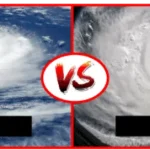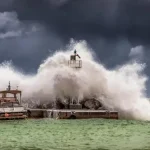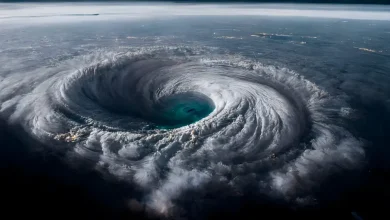Typhoons: Understanding Nature’s Powerful Storms

Typhoons are among the most powerful and destructive natural phenomena on Earth, capable of causing widespread devastation through heavy rains, powerful winds, and storm surges. Understanding how typhoons form, their impact, and how to prepare for them is essential for those living in regions frequently affected by these tropical cyclones.
What is a Typhoon?
A typhoon is a type of tropical cyclone that occurs in the northwest Pacific Ocean, primarily affecting countries like the Philippines, Japan, Taiwan, China, and parts of Southeast Asia. Typhoons are the same meteorological phenomenon as hurricanes and cyclones but are named differently based on the region in which they occur.
These intense storms are characterized by low-pressure systems, with strong winds circulating around a central “eye.” The winds must reach speeds of at least 74 miles per hour (119 km/h) to be classified as a typhoon. When winds exceed 150 miles per hour (240 km/h), the typhoon is considered to be a “super typhoon.”
How Typhoons Form
Typhoons develop over warm tropical waters, where sea surface temperatures are at least 26.5°C (80°F). Warm, moist air rises from the ocean, creating a low-pressure area beneath it. As this air rises, it cools and condenses, forming clouds and releasing latent heat, which further fuels the storm.
The Earth’s rotation causes the rising air to spin, and as the storm system intensifies, it begins to form a well-defined circular structure. The center of the storm, known as the “eye,” is relatively calm, while the area surrounding the eye, called the “eyewall,” experiences the most severe winds and rainfall. The energy of the storm continues to build as long as it remains over warm waters.
Typhoons generally weaken as they move over cooler water or land, losing their primary source of energy. However, by the time they make landfall, they can cause catastrophic damage, especially in coastal areas.
Typhoon Categories and Their Effects
Typhoons are classified based on the strength of their winds, and this classification helps determine the potential severity of the storm’s impact.
1. Tropical Depression (winds less than 39 mph or 62 km/h)
At this stage, the storm system has not yet reached typhoon strength. Rainfall may be intense, but wind speeds are relatively mild.
 Hurricane and Tropical Cyclone: Understanding the Powerful Storm Systems
Hurricane and Tropical Cyclone: Understanding the Powerful Storm Systems
2. Tropical Storm (winds between 39-73 mph or 63-118 km/h)
When wind speeds increase, the storm is classified as a tropical storm. It can bring heavy rains and cause localized flooding, but the wind damage is still limited.
3. Typhoon (winds between 74-149 mph or 119-239 km/h)
A fully developed typhoon can cause significant damage to buildings, trees, and infrastructure. The heavy rains associated with typhoons often lead to landslides and widespread flooding, particularly in mountainous regions.
4. Super Typhoon (winds exceeding 150 mph or 240 km/h)
A super typhoon is capable of causing catastrophic damage over a wide area. Entire towns can be flattened, and coastal regions may experience severe storm surges that can inundate vast areas. Super typhoons are the most dangerous form of tropical cyclone.
The Impact of Typhoons
Typhoons can have devastating effects on human life, property, and the environment. The severity of the impact depends on the size, strength, and duration of the storm, as well as the preparedness of the affected regions.
1. Strong Winds
The winds from a typhoon can cause widespread destruction, particularly in densely populated coastal areas. High winds can knock down power lines, damage buildings, and uproot trees. The eyewall, which surrounds the storm’s center, experiences the most intense wind speeds and is typically the most destructive area of the storm.
2. Heavy Rainfall and Flooding
Typhoons are often accompanied by torrential rainfall, which can lead to flash flooding, especially in low-lying areas. In regions with mountains or hills, the rainfall can trigger deadly landslides and mudslides, putting entire communities at risk.
3. Storm Surges
One of the most dangerous aspects of typhoons is the storm surge—a rise in sea level caused by the storm’s strong winds pushing ocean water onto the shore. Storm surges can cause severe coastal flooding, submerging homes, roads, and farmland. In extreme cases, entire towns can be swept away by the surging water.
4. Economic and Environmental Damage
The economic impact of typhoons can be immense. Homes, businesses, and infrastructure are often destroyed, leading to costly repairs and rebuilding efforts. Agriculture, a vital source of income for many affected countries, is frequently devastated by flooding and strong winds. In addition, the destruction of ecosystems and habitats can have long-term environmental consequences.
 Tsunami: Understanding Nature’s Most Powerful Wave
Tsunami: Understanding Nature’s Most Powerful Wave
Typhoons and Climate Change
Scientists are increasingly linking the intensity and frequency of typhoons to climate change. Rising global temperatures lead to warmer ocean waters, which provide more energy for the formation of typhoons. This results in stronger storms and more severe impacts. Additionally, rising sea levels increase the risk of higher storm surges and more extensive coastal flooding.
While climate change may not necessarily increase the number of typhoons, it is likely to make the strongest storms even more powerful, leading to greater destruction in the affected areas.
How to Prepare for a Typhoon
Preparation is key to minimizing the risks associated with typhoons. Here are some important steps individuals and communities can take to stay safe:
1. Stay Informed
Monitor weather forecasts and warnings from local authorities, especially during typhoon season. Early warning systems are essential for giving people time to evacuate or secure their homes.
2. Create an Emergency Kit
Prepare a kit with essential supplies such as food, water, first-aid materials, flashlights, batteries, and important documents. Make sure to have enough supplies to last several days in case of prolonged power outages or flooding.
3. Secure Your Home
Reinforce doors and windows to protect against high winds. If you live in a flood-prone area, elevate important belongings and consider installing flood barriers or sandbags.
4. Have an Evacuation Plan
Know the evacuation routes in your area and have a plan in place for where you will go if you need to evacuate. Make sure all family members are aware of the plan, and don’t forget to plan for pets as well.
5. Stay Indoors During the Storm
Once the typhoon hits, stay indoors and away from windows. Even after the eye of the storm passes, the winds can quickly pick up again. Avoid going outside until local authorities declare it safe to do so.
 Ocean Tides: The Rhythmic Movements of the Sea
Ocean Tides: The Rhythmic Movements of the Sea
Conclusion
Typhoons are powerful and potentially deadly storms, but with the right preparation and awareness, their impact can be mitigated. Understanding how typhoons form, recognizing their dangers, and knowing how to prepare for them are essential for anyone living in regions where these tropical cyclones occur. As climate change continues to affect weather patterns worldwide, being proactive and prepared for typhoons is more important than ever.






